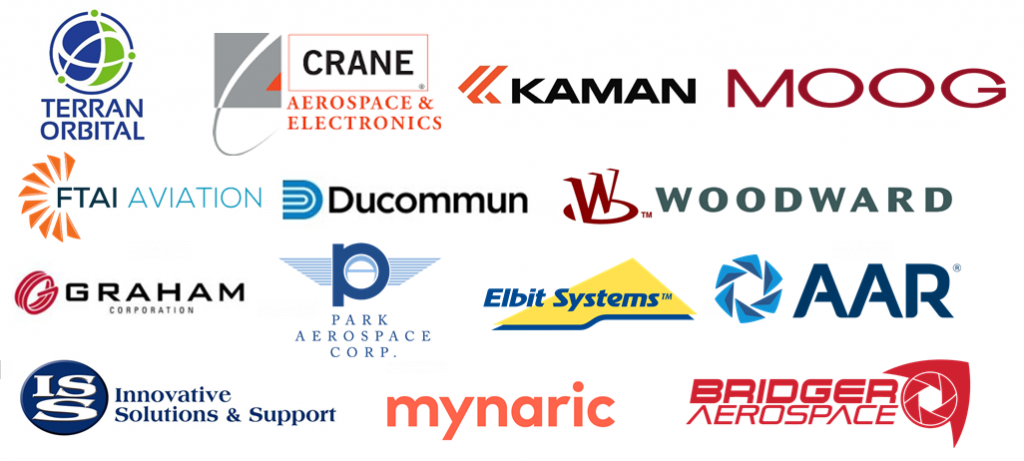Introduction
At our 29th Annual Aerospace & Defense Conference, the commercial aerospace presenters reaffirmed our view that the commercial aerospace market will return to a healthy state over the long term. Although the International Air Transport Association (IATA) expects world air travel to still be down 9.7% in 2023 compared to 2019, passenger traffic has grown at about a 5% CAGR since 1980 (Exhibit 1) and is expected to grow almost 4% annually to 2041. The expectation for a return to growth is driving long-term demand for repair and overhaul services and replacement parts, albeit potentially in a new normal where airlines use more salvaged parts from retired aircraft.
Exhibit 1 5% CAGR Since 1980

Source: Boeing CMO 2022
China remains a large part of the commercial aviation growth story. The country alone accounts for almost 21% (Table 1) of the global commercial deliveries expected over the next 20 years, more than any region except for North America (23%) and Europe (21%). Boeing has frequently noted China as a substantial market for commercial aircraft. China has 118 737 MAX orders and is estimated to account for roughly half of the almost 1,300 Unidentified/Other Leasing Companies or approximately 18% of the 737 MAX backlog.


The industry continues to believe the fundamentals that have driven air travel for the past five decades and doubled air traffic over the past two decades remain intact. In its 2023 CMO, Boeing projected delivery of 42,595 new airplanes for replacement and growth over the next 20 years (Table 2). Narrow-body aircraft will make up approximately 76% of the demand, or 32,420 airplanes. Wide-body airplanes make up 18%, or 7,440 aircraft and regional jets make up 5%, or 1,810 jets. The demand for these airplanes is driven in part by global economic growth, and roughly two billion new passengers since 2005, who are willing to spend on travel and tourism. In addition, industry deregulation facilitating low-cost carriers’ expansion into new markets and the removal of visa restrictions increases the ease of global travel.
The need for 42,595 passenger transports and freighters over the next 20 years averages out to slightly less than 2,000 new airplanes a year. Our combined production forecast for Boeing and Airbus is below this average annual rate (Table 3) suggesting that the commercial aerospace market post-2024 could remain healthy for some time.

Further, Boeing and Airbus have strong backlogs of 5,596 and 8,024 airplanes, respectively, or about 12 years of current production (Table 4). Despite COVID-19 and the continued Boeing 737 MAX halt on deliveries in China, unprecedented backlog support continued top-line growth for the OEMs and suppliers, backlogs remain robust.

The demand for narrow-body aircraft is heavily driven by the replacement of older, less efficient jets with new, fuel-efficient aircraft including the Boeing 737 MAX, Airbus A320neo, A220, Embraer E Jets, and the COMAC C919. All of the commercial aerospace companies presenting at the conference have content on these re-engined aircraft that should help them drive original equipment and aftermarket growth as the commercial aerospace industry returns to growth.
Strong demand, inflation, and the impact of supply chains on Commercial OEM and AM were the key topics at this year’s conference. Most companies expect a continued recovery in global commercial air travel. Increasing flight hours should drive the need for replacement parts, followed by OEM suppliers who have been burning down inventory as Airbus and Boeing produce and deliver more aircraft. Most suppliers have been able to preserve margins with targeted price increases. There is some lag effect with longer-term contracts rolling over and taking effect. The supply chain has slowed growth in almost all aspects of commercial aerospace. While companies have adjusted to the near-term new normal, few are altering long-term strategy.
Defense
In 2023, the U.S. defense budget grew 12.5% to $852 billion. Over the last five years, the defense budget has grown at a 4.9% CAGR. Going forward, the budget is projected to modestly increase at about a 1.4% CAGR, as illustrated in Exhibit 3. We believe this presents an appealing investment opportunity, which was reiterated by presenters at the conference. Programs like the JSF, B-21, THAAD, GBSD, and GMD are driving growth for many suppliers across the industry.
After the invasion of Ukraine by Russia in February 2022, NATO members have said they will increase defense spending in the face of what NATO has described as the most serious security crisis in a generation. APAC NATO Partners as well as other NATO Ally countries have committed to stepping up defense spending. In recent years, most NATO members have begun spending more on defense (Table 6). We estimate if NATO members ex-US, were to increase defense spending to the 2% target rate, it would be an additional $82 billion of defense spending or about 5% growth to the collective NATO defense spending.


However, faster foreign growth combined with sequestration has reduced the United States’ share of global defense spending to ~40% versus 43% in 2010. Meanwhile, over the last decade, contentious countries like China and Russia have increased their investment in defense spending, as illustrated in Table 6. While the U.S. footprint in the Middle East has decreased significantly, geopolitical instability has continued to grow. Tensions persist with Iran and North Korea’s nuclear weapons programs remaining opaque. In addition, China has carried out repeated military exercises in the South China Sea near the Paracel Islands and continues to assert its claim on the Spratly Islands.
Exhibit 2

Source: Department of Defense
Exhibit 3

Source: Department of Defense
AAR Corp (AIR – $59.51 – NYSE) Aerospace Conference Highlights

COMPANY OVERVIEW
AAR Corp. is headquartered in Wood Dale, Illinois, and provides products and services to commercial aviation, government, and defense markets worldwide. It operates through Aviation Services and Expeditionary Services segments. The Aviation Services segment engages in the lease and sale of new, overhauled, and repaired engine and airframe parts and components, as well as aircraft; and offers customized flight hour component inventory and repair, warranty claim management, and outsourcing programs for engine and airframe parts and components. This segment also provides fleet management and operations of customer-owned aircraft for the U.S. Department of State; customized performance-based supply chain logistics programs, which include material planning, sourcing, logistics, information, and program management, airframe and maintenance planning, and component repair, and overhaul services for U.S. Department of Defense and foreign governments. Further, it offers airframe inspection, maintenance, repair and overhaul, painting services, line maintenance, modifications, structural repairs, avionics service and installation, exterior and interior refurbishment, and engineering services and support; and repair and overhaul components including landing gears, wheels, and brakes for commercial and military aircraft; and operates six airframe maintenance facilities and one landing gear overhaul facility. The Expeditionary Services segment designs, manufactures, and repairs transportation pallets containers, and shelters for military and humanitarian tactical deployment activities, including armories, supply and parts storage, refrigeration systems, tactical operation centers, briefing rooms, laundry and kitchen facilities, water treatment, and sleeping quarters, as well as engages in provision of engineering, design, and system integration services for specialized command and control systems.
Reason For Comment
The following are key takeaways from AAR’s CFO Sean Gillen and Vice President of Strategy Dylan Wolin at our 29thAnnual Aerospace & Defense Conference:
· OEM Production Tailwind. The production delays have led to extended lifetime use for aircraft, which has decreased the amount of Used Serviceable Material (USM). Looking forward, once the OEMs are able to ramp production rates, more planes should be retired and AAR will be able to source more USM for customers in the aftermarket. Additionally, demand for AAR’s services on mid to late-life aircraft should remain elevated with the older-than-average fleet.
· Trax Acquisition. AAR acquired Trax in March 2023. It is a software system that is used to support every element of aircraft maintenance, which is sold to airlines. Trax is only one of three independent providers for this service. AAR had been looking to add more intellectual property and high-margin-based offerings that are consistent with its aftermarket objectives. Positively, the customer bases between AAR and Trax are complementary. AAR services large airlines, while Trax was a software provider to small and mid-sized airlines. Therefore, significant cross-selling opportunities exist.
· Margin Expansion. Pre-Covid, AAR had an operating margin of around 5.5%. Today, it is 7.5% or 200bps of expansion. Additionally, revenue is still slightly down. The two biggest drivers of margin expansion were in the hangar network and the commercial Power By the Hour (PBH) business. Previously, the hangar network pursued sales growth at the expense of profitability, which is no longer the case. Further, COVID opened the door for AAR to renegotiate its PBH contracts for better profitability.

Bridger Aerospace (BAER – $7.78 – NASDAQ) Aerospace Conference Highlights

COMPANY OVERVIEW
Headquartered in Belgrade, Montana, Bridger Aerospace Group Holdings, Inc. provides aerial wildfire management, relief and suppression, and firefighting services to federal and state government agencies in the United States. It offers fire suppression services, such as direct fire suppression aerial firefighting support services for ground crew to drop large amounts of water quickly and directly on wildfires. The company also provides aerial surveillance services, including fire suppression aircraft over an incident and tactical coordination with the incident commander through its manned and unmanned aircraft. It operates an aircraft fleet of 21 planes.
Reason For Comment
The following are key takeaways from Bridger’s CIO McAndrew Rudisill at our 29th Annual Aerospace & Defense Conference:
· Company Background. CEO Tim Sheehy, who is a retired Navy SEAL, identified the importance of aerial surveillance during his time in combat. After leaving the military in 2016, Tim wanted to put this idea to use in civilian applications. The big change occurred when the US Forest Service requested suppression planes to put out wildfires, rather than just identify them. Currently, the company has 30 aircraft and is the largest provider of aerial wildfire suppression.
· Increasing Wildfires. Management points to climate change as being the driving factor behind the increased number of wildfires. Additionally, people have moved into areas that were previously uninhabited. This has created more opportunities for fires to start in secluded locations that would not have been the case 30 years ago.
· Competitive Advantages. The company has six “Super Scooper” aircraft for fire extinguishment. In total, there are only eight in all of North America. These planes can pick up 1,400 gallons of water in twelve seconds. Additionally, the planes can fly for up to eight hours so many trips to pick up water and drop it on fires can be done in one flight. Bridger is working with the government to get its planes in quicker, so the company can attack wildfires in infancy before they get too large and more difficult to extinguish.
· Addressable Market. Today, more than $10 billion per year is spent on fire extinguishment. Additionally, this is a growing market as fires occur more frequently. Bridger has a very small, but increasing market share, generating $90 million. Most of the market is sourced by public operators. Furthermore, few operators are privatized and have the same scale as Bridger.

Crane (CR – $89.31 – NYSE) Aerospace Conference Highlights

COMPANY OVERVIEW
Crane Company, based in Stamford, CT, is a diversified manufacturer of highly engineered industrial products. Operations are comprised of three segments: Aerospace & Electronics, Process Flow Technologies, and Engineered Materials. Primary end markets include aerospace, defense, and space, process industries, non-residential and municipal construction, and a wide range of general industrial end markets.
Reason For Comment
The following are key takeaways from Crane’s CFO Rich Maue, President of A&E John Higgs, Executive Vice President Alex Alcala, and Vice President of Investor Relations Jason Feldman at our 29thAnnual Aerospace & Defense Conference:
· Demand Strength. Management was optimistic about near-term commercial aerospace demand strength and pointed out that OEMs are still in ramp mode. This bodes well for Crane since it has an attractive portfolio of proprietary components spread across a broad set of platforms. Additionally, Crane is experiencing continued strength in its defense business. The growth in defense spending is expected to continue, which should be a positive tailwind for Crane over the next decade.
· Post Spin Takeaways. Investor interest has never been higher for Crane than it has been following the spin-off. The stock is at the same price from last year except the company is one-half the size, which has created over $2 billion in value for shareholders. According to management, there has been three times as much activity from buy-side investors than prior to the spin. Management is working with sell-side analysts to communicate Crane’s value proposition and get more recognition.
· M&A Opportunity. Management reiterated its desire to conduct M&A and highlighted the interesting opportunities in avionics, niche defense products, and the pharmaceutical industry. Further, valuations have come down and present more attractive returns. The pipeline is more robust with a larger amount of willing sellers. The recovery in the A&D industry from the pandemic and positive tailwinds have been a driving factor in the increased number of companies being put up for sale.
· Pricing Upside. Value-based pricing provides upside to Crane’s guidance. Management understands in many situations Crane is the only producer of a certain product, which is critical for a customer’s operation. Thus, customers are willing to pay more to get the equipment they need even if at a much higher price. In many scenarios, Crane has doubled prices for specialized work with minimal pushback. Interestingly, the company raised prices by 1,600% on a specialized pump product without seeing any demand change. Management is working to understand the importance of its products to customers so it can price Crane’s services accordingly.

Ducommun (DCO – $43.95 – NYSE) Aerospace Conference Highlights

COMPANY OVERVIEW
Ducommun, based in Santa Ana, CA, is a leading global provider of engineering and manufacturing services for high-performance products and high-cost-of-failure applications used primarily in the aerospace and defense, industrial, and medical industries. The company operates through two primary segments: Electronic Systems and Structural Systems.
Reason For Comment
The following are key takeaways from Ducommun’s CFO Summan Mookerji at our 29th Annual Aerospace & Defense Conference:
· OEM Production Rates. Recently, the Spirit Aerosystems’ quality issues and labor strikes have destabilized consistent OEM production rates. The 737 MAX is being produced at a monthly production rate in the mid-20s, which is below Ducommun’s initial estimates. However, production is moving in the right direction and ramps are expected to continue increasing, barring any additional unexpected issues.
· Defense Demand. Ducommun has planned over the last few years to position itself on next-generation programs that will drive growth. The main areas of focus include missile defense, radar systems, and electronic warfare. The company is well positioned across the board to benefit from the increased defense spending environment. Unlike the aerospace segment, which derives a large portion of sales from the 737 MAX, the defense business has no platform that accounts for greater than 10% of sales.
· Product Overview. Ducommun’s products are split between two main segments: Electronic Systems and Structures. According to Summan, the ROIC associated with the Electronic Systems segment is much higher than that of Structures. This is due to the proprietary status of many of the electronic components Ducommun manufactures, compared to the “build to print” structures business.
· Recent Acquisition. Ducommun purchased BLR Aerospace for $115 million at the end of April 2023. The company’s key product is the fast fin system, which allows helicopters to operate at higher altitudes and carry more weight. This is a great value proposition for firefighting or military applications. Additionally, this product is proprietary in nature and Ducommun obtained the patent protection from the acquisition.
· Restructuring Update. The plan is progressing well and is currently on track to shut down two facilities by the end of 2023. Ducommun is building up inventory to facilitate this transition. Additionally, large customers such as Boeing and Raytheon have been supportive.

Elbit Systems (ESLT – $208.12 – NASDAQ) Aerospace Conference Highlights

COMPANY OVERVIEW
Elbit Systems Ltd., based in Haifa, Israel, is an international high-technology company engaged in a wide range of defense, homeland security, and commercial programs throughout the world. The company, which includes Elbit Systems and its subsidiaries, operates in the areas of aerospace, land and naval systems, command, control, communications, computers, intelligence surveillance and reconnaissance (“C4ISR”), unmanned aircraft systems, advanced electro-optics, electro-optic space systems, EW suites, signal intelligence systems, data links, and communications systems, radios, cyber-based systems, and munitions. The company also focuses on the upgrading of existing platforms, developing new technologies for defense, homeland security, and commercial applications, and providing a range of support services, including training and simulation systems.
Reason For Comment
The following are key takeaways from Elbit’s Director of Investor Relations, Rami Myerson at our 29th Annual Aerospace & Defense Conference:
· C4I and Cyber. Elbit is seeing strong growth in the command, control, compute and communicate, and intelligence market. This includes products like sensors, signal intelligence, and electronic warfare (jammers). Additionally, Ukraine has shown increased demand for training and simulation equipment to simulate surface-to-air threats. The fastest-growing segment of the DoD’s budget is within electronics and C4I. Therefore, Elbit is in an envious position having solid market positions within attractive areas of the defense industry.
· Strong Backlog. Elbit has been able to successfully grow its global backlog. Two driving factors are the increased demand in Europe as a reaction to the Ukraine War and The Abraham Accords. In Europe, governments seeking to build up stockpiles to prepare for any additional conflicts. Elbit thinks more agreements in the Middle East such as the Abraham Accords can lead to increased demand.
· Growth Strategy. Elbit implements a global growth strategy whereby it establishes a physical footprint and develops a relationship with the local government. The company has been able to execute this approach throughout different parts of the world, such as in Europe, the United States, and Asia. The diverse geographical nature of Elbit should allow for steady growth moving forward, rather than being tied to one government’s defense spending budget.
· Hypersonic Solution. Elbit has a strong position on high-powered laser systems to target hypersonic weapons, which have detection and tracking capabilities. Hypersonic defense will be critical as warfare becomes more technologically advanced. Additionally, Elbit has attractive space-based platform exposure, which could be an additional growth driver.

FTAI Aviation (FTAI – $34.74 – NASDAQ) Aerospace Conference Highlights

COMPANY OVERVIEW
Headquartered in New York, New York, FTAI Aviation Ltd. owns and acquires infrastructure and related equipment for the transportation of goods and people worldwide. It operates through two segments: Aviation Leasing and Aerospace Products. The Aviation Leasing segment owns and manages aviation assets, including aircraft and aircraft engines, which it leases and sells to customers. As of December 31, 2022, this segment owned and managed 330 aviation assets consisting of 106 commercial aircraft and 224 engines, including four aircraft and one engine that were located in Ukraine, and eight aircraft and seventeen engines that were located in Russia. The Aerospace Products segment develops, manufactures, repairs, and sells aircraft engines and aftermarket components for aircraft engines.
Reason For Comment
The following are key takeaways from FTAI’s CEO Joe Adams at our 29th Annual Aerospace & Defense Conference:
· Successful Spin-off. In August 2022, FTAI successfully spun off its infrastructure business, which created a pure-play aviation leasing and products company. Since FTAI removed its K-1 tax status, the company can now be owned by a larger investor base. Additionally, the FTAI story is much simpler and investor feedback has been positive.
· Aviation Leasing Tailwinds. FTAI’s primary expertise is in the aviation leasing industry. The company focuses primarily on the CFM-56 engine, which is the most commonly used commercial engine. Management analyzes a leasing opportunity in three parts, which include the body of the plane and the two engines. Since most of the value of an aircraft is derived from engines, in some cases management will purchase a plane and scrap the body, then go and lease the engines. Lastly, this business is a beneficiary of the OEM production delays and the recent GTF engine issues.
· Module Factory. In 2021, FTAI entered the aerospace products. The company has successfully built this business from the ground up to approximately $120 million of annual EBITDA which is growing rapidly. Since the CFM-56 is built in three sections or modules, FTAI identified that it could simply replace a module with a spare one from inventory and significantly lower the cost and time to repair an engine in shop. Normally, the engine would have to be disassembled, repaired, and put back together. This process could take nearly a year whereas FTAI is able to do it in months depending on which module needs to be replaced. FTAI is growing this business rapidly and projects to achieve $500 million in EBITDA by 2026.
· PMA Opportunity. FTAI has a 25% partnership in a joint venture with Chromalloy, a Parts Manufacturer Approval (PMA) provider. The joint venture is attempting to get four engine parts PMA approval. The agreement would allow FTAI to purchase these parts at cost from Chromalloy as well as receive sale royalties from other customers. Longer term, PMA approval would be a significant advantage for FTAI since it would allow the company to cut its cost structure in half for engine repairs. For context, Chromalloy has vast experience getting parts PMA approval, and an update on approval is expected at the end of 2023.

Graham Corp (GHM – $16.69 – NYSE) Aerospace Conference Highlights

COMPANY OVERVIEW
Graham Corporation is engaged in the design and manufacture of fluid, power, heat transfer, and vacuum technologies for the defense, space, energy, and process industries. Its Graham Manufacturing and Barber-Nichols global brands are built upon engineering expertise in vacuum and heat transfer, cryogenic pumps, and turbomachinery technologies. For the defense industry, its equipment is used in nuclear and non-nuclear propulsion, power, fluid transfer, and thermal management systems. For the space industry, its equipment is used in propulsion, power, and energy management systems and for life support systems. For the chemical and petrochemical industries, its equipment is used in fertilizer, ethylene, methanol, and downstream chemical facilities. It offers products for power plant systems, torpedo ejection and power systems, thermal management systems, power generation systems, thermal management systems, chemical and petrochemical processing, and cooling systems, among others.
Reason For Comment
The following are key takeaways from Graham’s CEO Dan Thoren, CFO Chris Thome, and President of Barber-Nichols Matt Malone at our 29th Annual Aerospace & Defense Conference:
· Strong Defense Market Momentum: More than three-quarters of Graham’s record $322 million total backlog at June 2023 is tied to the U.S. Navy, where Graham is receiving substantial follow-on awards for its torpedo ejection systems as well as heat exchangers and surface condensers (used to manage temperatures around the nuclear reactor core of Virginia and Columbia class submarines as well as nuclear-powered aircraft carriers). The company recently received a $13.5 million investment from a major Naval contractor prime to expand production at Graham’s Batavia, NY facility.
· Upside in Space and New Energy Markets: The commercial space market is a rapidly growing part of Graham’s portfolio (accounting for just $12 million, or 7%, of total revenue but growing at double-digit rates), where the company serves SpaceX, Blue Origin, Virgin Galactic, and NASA (Graham solutions include rocket engine turbo pumps, thermal management systems for satellites, and astronaut life support systems). Within the new energy market, the company’s cryogenic pumps and heat exchangers are being applied to a range of hydrogen production and distribution applications. Graham’s reactor coolant pumps continue to gain traction in the emerging small modular reactor and nuclear fusion markets. In addition, more recently, the company has seen an uptick in demand for its surface condensers used at geothermal plants with Graham’s product enabling lithium extraction from geothermal brine (providing an incremental revenue source for plant operators).
· Positive Margin Trajectory: The company is nearly complete on shipping its lower-margin first-article Navy submarine equipment and expects significant profitability improvement as it leverages better pricing (from its sole-source supplier status) and production learnings from repeat output processes.
· Summarizing Highlights: Graham is a well-managed business under the new leadership team who took over approximately two years ago. The company’s medium-term (Fiscal 2027) targets imply a near tripling of Adj. EBITDA and management have already indicated that the company is tracking ahead of these goals. Further, Graham has a strong net cash balance sheet and will generate substantial free cash flow over the next four years, providing capital allocation upside.

Innovative Solutions & Support (ISSC – $7.63 – NASDAQ) Aerospace Conference Highlights

COMPANY OVERVIEW
Headquartered in Exton, Pennsylvania, Innovative Solutions and Support, Inc., a systems integrator, designs, develops, manufactures, sells, and services flight guidance, autothrottle, and cockpit display systems in the United States and internationally. It offers flat panel display systems that replicate the display of analog or digital displays on one screen and replace existing displays in legacy aircraft, as well as being used for security monitoring on-board aircraft and as tactical workstations on military aircraft; and flight management systems that complement the flat panel display system upgrade for commercial air transport aircraft. The company also provides integrated standby units, which incorporate the measurement and display of attitude, altitude, airspeed, and navigation data into a single standby/backup navigation instrument for military, commercial air transport, and corporate/general aviation applications. In addition, it offers digital air data computers that calculate various air data parameters, such as altitude, airspeed, vertical speed, angle of attack, and other information; integrated air data computers and display units, which calculate and convey air data information; altitude displays that convey aircraft altitude measurements; airspeed displays that convey various airspeed measurements; and altitude alerters. Further, the company offers engine and fuel displays that convey information related to fuel and oil levels, and engine activity, including oil and hydraulic pressure and temperature; integrated global navigation systems; ThrustSense, a full regime autothrottle; and utility management systems. It serves commercial air transport carriers and corporate/general aviation companies, the Department of Defense and its commercial contractors, aircraft operators, aircraft modification centers, government agencies, and foreign militaries, as well as original equipment manufacturers
Reason For Comment
The following are key takeaways from ISSC’s CEO Shahram Askarpour at our 29th Annual Aerospace & Defense Conference:
· New Leadership. Under the late CEO and founder Geoffrey Hedrick, ISSC operated as a private company. Growth avenues were not pursued, and excess cash was paid out via dividends rather than reinvested into the business. The new team is led by ISSC engineering veteran, Shahram Askarpour who has indicated the company will operate more aggressively than in the past and pursue growth opportunities.
· Honeywell Product Acquisition. In July 2023, ISSC announced it would be acquiring two product lines from Honeywell Aerospace: radio systems and GPS units. The total deal price was $36 million, which was funded by $16 million of cash on hand and a $20 million term loan. Management expects to increase sales and EBITDA from 2022 by 40% and 75%. ISSC has the opportunity to purchase more small system product lines and service the aftermarket.
· High Aftermarket Content. Over one-half of ISSC’s sales are derived from the aerospace aftermarket. The company’s primary product is display screens for the cockpit. ISSC retrofits old aircraft with analogue devices to comply with the FAA’s Reduced Vertical Separation Minimum. Essentially, ISSC products allow more precision for the pilot during flight, which enhances safety.

Kaman Corp. (KAMN – $19.21 – NYSE) Aerospace Conference Highlights

COMPANY OVERVIEW
Kaman Corporation, headquartered in Bloomfield, Connecticut, produces and markets aircraft bearings and highly engineered components; super precision miniature ball bearings for the medical, industrial, and aerospace markets; and metallic and composite aerostructures for commercial, military, and general aviation fixed and rotary wing aircraft. In 2022, Kaman purchased Parker Hannifin’s Wheel and Brakes Division, allowing the company access to the aircraft landing system market. The company operates in North America, Europe, the Middle East, Asia, Oceania, and other countries.
Reason For Comment
The following are key takeaways from Kaman’s CEO Ian Walsh at our 29th Annual Aerospace & Defense Conference:
· Portfolio Transformation. Since Ian Walsh was appointed CEO at the end of 2020, the focus has been on quality of earnings. Previously, there was a lot of variance and volatility, which was driven by the joint programmable fuze (JPF), the K-MAX, and structures business. Today, JPF is no longer in Kaman’s portfolio and the company no longer manufactures the K-MAX. Additionally, Kaman is working to strengthen the structures business and diversified its aerospace exposure with the Parker Wheel and Brakes acquisition.
· Engineered Products. The Engineered Products segment is the “crown jewel” of Kaman. Recently, the company added the Parker Wheel and Brakes business. Kaman develops, manufactures, and sells proprietary products that solve customer-specific issues. The business benefits from high barriers to entry due to the required FAA approval for each part. This allows for attractive pricing power. Lastly, cash flow generation is high.
· Cost Structure Optimization. After the Kaman Distribution business was sold, there were efficiencies that needed to be realized. Efficiency drivers were shutting down the K-MAX program and consolidating manufacturing facilities. Kaman estimates it can cut out $25 million annually by the end of 2024. Currently, Kaman is focused on new cost-cutting strategies within the Engineered Products and Structures business, which already seems to be making progress.
· Parker Wheel and Brakes. The integration is done and has already exceeded expectations. There is an attractive growth opportunity, which had not been fully pursued as a subsidiary to Parker Hannifin. Currently, the business has exposure to 100 platforms and a strong reputation with customers for high-quality products.
· Capital Allocation Strategy. Kaman has two near-term capital allocation priorities: organically deleverage and focus investments on Engineered Products. The company took on a significant amount of debt to acquire the Parker Wheel and Brakes business and intends to use cash from operations to pay this down.
· Additional Growth Avenues. Currently not in acquisition mode, but always have an eye on potential bolt-ons. Positively, there is significant customer overlap between the Engineered Products business and Parker Wheel and Break. This creates cross-selling growth opportunities.

Moog (MOG’A – $112.24 – NYSE) Aerospace Conference Highlights

COMPANY OVERVIEW
Moog Inc. is a worldwide manufacturer of precision control components and systems. Moog’s control systems are on military and commercial aircraft, satellites, space and launch vehicles, missiles, automated industrial machinery, marine applications, and medical equipment. Aircraft Controls manufactures and integrates primary and secondary flight controls for military and commercial aircraft as well as providing aftermarket support. Space Controls specializes in complex motion and fluid controls systems for difficult operating environments. Its markets include satellites and space vehicles, defense controls, launch vehicles, strategic missiles, missile defense, and tactical missiles. Industrial Controls serve the plastics making machinery, simulation, power-generating turbines, test, metal forming, and heavy industries. Its products range from injection and blow molding machines to electromechanical motion simulation bases to electrical and hydraulic servovalves. Components’ primary products are slip rings, fiber optic rotary joints, and motors.
Reason For Comment
The following are key takeaways from Moog’s CEO Pat Roche and CFO Jennifer Walter at our 29th Annual Aerospace & Defense Conference:
· Cross-Industry Technology. Moog is primarily an aerospace and defense company, but it also operates an industrial equipment business. Management has intelligently identified cross-selling opportunities where some equipment can be slightly modified from defense use to an industrial purposes. For instance, Moog was trying to address a construction machine problem, but the engineers within the division could not solve it. Management used engineers from the aerospace segment to solve this problem. According to management, there are many low-hanging fruit opportunities to cross-sell and increase margin.
· Operational Efficiencies. Moog has been working to consolidate its factory footprint to streamline operations. Management highlighted its 80/20 plan, which will be 80% cost-cutting and 20% price increases to achieve higher margins. The plan seems practical since there is still a long runway ahead to close redundant factories. Additionally, management is placing a greater focus on value-based pricing. Given that Moog has a large portfolio of proprietary aviation products, the company will have large potential to raise prices without a demand drop-off.
· 2026 Targets on Track. Management reiterated its ability to hit the guidance laid out during its investor day in early June. Assuming the successful OEM ramp in monthly production rates, Moog’s guidance could prove to be conservative and have additional upside.
· FLRAA Exposure. Management is excited about being placed under contract with Textron to work on the next-generation V-280. Initially, the contract will fund core design and development activities through the middle-tier acquisition phase of the program. Moog products on the V-280 include actuators, cockpit controls, and converter units. Once FLRAA goes into full production, the program will be highly profitable for Moog.

Mynaric (M0YN – €17.45 – XETRA) Aerospace Conference Highlights

COMPANY OVERVIEW
Mynaric AG, headquartered in Gilching, Germany, engages in developing and manufacturing advanced laser communication technology for long-distance data transmission between moving objects for wireless terrestrial, airborne, and space applications in Germany and internationally. The company offers CONDOR, an optical inter-satellite link flight terminal for satellite-to-satellite communications in space; and HAWK, an airborne flight terminal for air-to-air and air-to-ground links of airborne vehicles. Its products provide connectivity solutions to link satellites, high-altitude platforms, unmanned aerial vehicles, aircraft, and the ground.
Reason For Comment
The following are key takeaways from Mynaric’s CEO Mustafa Veziroglu and CFO Stefan Berndt-von Bülowat our 29th Annual Aerospace & Defense Conference:
· Scalable Laser Communication. Mynaric uses secure LASER communication to connect satellite constellation mesh. This is safer and faster than the current satellite communication method today. Most importantly, it is nearly impossible to jam a LASER-based communication, allowing for practical military use. Recently, the company secured a $36 million contract with Northrop Grumman for a program led by the Space Development Agency. Mynaric’s backlog is 350 units and management anticipates capacity of 2,000.
· Recurring Revenue Opportunity. Since satellites have a five-year life, Mynaric sees the potential for a recurring revenue opportunity to continually put its communication technology on new satellites. In the future, Mynaric estimates it could achieve a 50% gross margin and generate $1 billion in sales over the next five years. Management compared Mynaric to the “American Tower” of space, where it essentially acts as an intermediary for space-based communication.
· Production Intricacies. Mynaric has most of its production in a company-owned factory in Germany. It is the world’s first dedicated serial production facility for laser communication. The factory’s capacity and Mynaric’s ability to ramp production has been an appealing dynamic for customers when choosing a partner. Additionally, the facility has been used as a sandbox to establish large-scale production capabilities.
· Product Overview. Mynaric has two main products, the HAWK and CONDOR terminals. The HAWK terminal is for airborne and ground-based communication and CONDOR is for space-based. Management pointed to its excitement for the CONDOR terminal, which has a faster growth rate than HAWK given the exposure to the space market.

Park Aerospace (PKE – $14.34 – NYSE) Aerospace Conference Highlights

COMPANY OVERVIEW
Headquartered in Westbury, New York, Park Aerospace Corp., formerly known as Park Electrochemical Corp., is an aerospace company that develops and manufactures solution and hot-melt advanced composite materials used to produce composite structures for the aerospace market in North America, Asia, and Europe. It offers advanced composite materials, including film adhesives and lightning strike protection materials that are used to produce primary and secondary structures for jet engines, large and regional transport aircraft, military aircraft, unmanned aerial vehicles, business jets, general aviation aircraft, and rotary wing aircraft. The company also provides specialty ablative materials for rocket motors and nozzles; and specially designed materials for radome applications. In addition, it designs and fabricates composite parts, structures and assemblies, and low-volume tooling for the aerospace industry.
Reason For Comment
The following are key takeaways from Park’s CFO Matt Farabaugh at our 29th Annual Aerospace & Defense Conference:
· Facility Expansion Complete. In 2018, Park announced it would be expanding its Newton, KS Manufacturing and Development Facilities. The expansion, which is now complete, added 90,000 square feet and cost approximately $20 million. This doubled the size of the Newton facility.
· Niche Military Programs. Park is pushing to expand into niche military programs, which has been a strong market. The main programs are rocket nozzles, aircraft structures, and drones. The company pointed to the Ukraine War as a driving factor for increased demand. Park thinks foreign governments are looking to stockpile even after the conflict concludes, which will lead to a period of elevated demand.
· Supply Chain Update. According to Park, the supply chain was the main impediment to recovery and ramp-up for both military and commercial aerospace industries. Positively, the demand remains strong. Electronic components, engines, and raw materials were the largest drivers in delays. Park was able to circumvent raw material delays and delivered to Airbus on time.
· Cash Rich Balance Sheet. Park has zero long-term debt and reported $81.1 million of cash and marketable securities during its last earnings report. The company has paid a regular cash dividend for 38 years without missing a distribution. In total, Park has distributed $583 million or about $28.50 per share since 2005.
· GE Aviation Update. Park is the sole source supplier for composite materials on engine nacelles and thrust reversers for multiple Middle River Aerostructure Systems, including the A319neo and A320neo with LEAP-1A engines, along with many more. Engine shipments are expected to continue ramping, which will be a nice tailwind for Park.

Terran Orbital (LLAP – $0.78- NYSE) Aerospace Conference Highlights

COMPANY OVERVIEW
Headquartered in Boca Raton, FL, Terran Orbital Corporation manufactures and sells satellites for the aerospace and defense industry in the United States. It operates through two segments, Satellite Solutions and Earth Observation Solutions. The Satellite Solutions segment offers end-to-end satellite solutions, including spacecraft design, development, launch services, and on-orbit operations for critical missions across a range of applications in various orbits to governmental agencies and commercial businesses. The Earth Observation Solutions segment develops, builds, launches, and operates a constellation of Earth observation satellites that have synthetic aperture radar capabilities to provide Earth observation data and mission solutions. The company was founded in 2013.
Reason For Comment
The following are key takeaways from Terran Orbital’s CEO Marc Bell at our 29th Annual Aerospace & Defense Conference:
· Cube Satellite. Terran Orbital invented the “Cube Satellite,” which can be held in the palm of a hand. Terran has seven types of satellites with different sizes that can be applied to a mission-specific need. This has allowed for decreased time between satellite production and launch to space. For instance, Terran is able to build and deliver its products within 30 days and allots an additional 30 days for launch. On the contrary, many prime contractor built satellites could take over two years to manufacture and launch versus Terran’s 60-day process. Also, there is also a large price discrepancy, whereby Terran can build satellites for millions of dollars versus larger primes in the billions.
· Automation and Efficiency. Terran utilizes robots to manufacture the satellites, which creates operational efficiencies. Impressively, the company builds these robots in-house. Additional efficiencies are realized through Terran’s vertical supply chain. This has allowed the company to be faster and more responsive to customers.
· Facility Expansion. Terran is rapidly expanding production efforts and recently added a 60k-square-foot expansion to its current manufacturing facility. Further, the company is building a new, 80k square foot assembly line that will be designated as a clean room. This connects back to Terran’s efforts to vertically integrate its supply chain, so the entire manufacturing process can be conducted under one roof.
· Competition. Its largest competitors include Boeing, Northrop Grumman, and Raytheon. CEO Marc Bell pointed out that these companies are much bigger than Terran and as a result, have significantly higher overhead. Terran only has 650 employees and 370 satellites on its production line. The company has very little overhead and its workers are non-union.
· Lockheed Agreement. Lockheed Martin owns roughly one-third of Terran. Although Terran competes with Lockheed on some contracts, Marc Bell pointed out the need for a “big brother” to guide the company in the right direction. Given Lockheed’s desire to expand into the fast-growing space business, the partnership makes a lot of sense.
October 9, 2023

Woodward (WWD – $125.31- NYSE) Aerospace Conference Highlights

COMPANY OVERVIEW
Woodward Inc., based in Fort Collins, CO, is a manufacturer and service provider of control solutions for the aerospace and industrial markets. The company operates in two segments: Aerospace and Industrial. Woodward products include fuel pumps, metering units, actuators, air valves, specialty valves, fuel nozzles, and thrust reverser actuation systems for turbine engines and nacelles, as well as flight deck controls. These products are used on commercial and private aircraft and rotorcraft, as well as military fixed-wing aircraft and rotorcraft.
Reason For Comment
The following are key takeaways from Woodward’s Director of Investor Relations Dan Provaznik at our 29thAnnual Aerospace & Defense Conference:
· Commercial Aerospace. Woodward is participating in the ramp of the 737 Max and the A320neo with its actuation and motion control products. Additionally, the company has significant content on the LEAP and GTF engines. Long term, Woodward is well positioned across a diverse set of dominant, high-production platforms.
· Supply Chain Stabilizing. Given the constantly changing supply chain, Woodward has been investing to guarantee continuity. The company had many supply chain-related difficulties in 2022, but it now seems to be stabilized. Further, Woodward is working to identify potential issues quarters in advance, so solutions can be created in the present. Previously, there were large inefficiencies with the labor force because parts were not available to be utilized.
· Broad Defense Exposure. Woodward has been in defense for many years, but it is not the company’s primary focus. Currently, Woodward has content on the F-35, F-16, F-18, and many more key platforms. On a negative note, guided weapons have seen a decline in demand. However, this could reverse as governments look to stockpile reserves after witnessing these weapons used in Ukraine.
· Industrial Business. The industrial business essentially has the same function as products in Woodward’s aerospace business. For instance, a fuel-metering device on the LEAP engine can have many similarities to that used for industrial purposes. The focus is fuel and motion control, and oil and air management systems. Additionally, Woodward has seen some sales volatility for a fuel control system in China that goes into a natural gas truck engine. Over the last twelve months, this business was almost zero, but recently order activity has risen. Unfortunately, there is minimal long-term visibility, unlike for the aerospace segment.
· Aerospace Aftermarket. Pre-2020, Woodward took a cost-plus approach to pricing. Starting in 2021 and 2022, the company identified the inflationary pressures on the business and began to take more price. Additionally, Woodward is the sole source manufacturer for many products, which allows it to price a product commensurate with its true value customers, which was not the case in the past. In 2023, the company targeted a 5% price increase, but it will actually now be around 7%.












